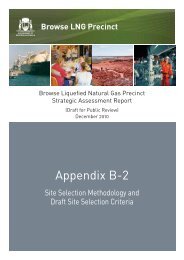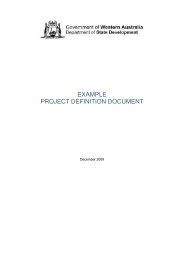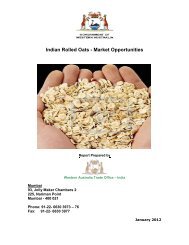Browse LNG Precinct - Public Information Booklet - Department of ...
Browse LNG Precinct - Public Information Booklet - Department of ...
Browse LNG Precinct - Public Information Booklet - Department of ...
Create successful ePaper yourself
Turn your PDF publications into a flip-book with our unique Google optimized e-Paper software.
<strong>Public</strong> <strong>Information</strong> <strong>Booklet</strong><br />
During plant operation, regular vessel movements will include <strong>LNG</strong> and condensate<br />
carriers. The number <strong>of</strong> vessels that will visit the <strong>Precinct</strong> relates to the capacity <strong>of</strong> the<br />
<strong>LNG</strong> processing facilities and the size <strong>of</strong> the <strong>LNG</strong> carriers. As a guide, export <strong>of</strong> 11<br />
million tonnes per annum <strong>of</strong> <strong>LNG</strong>, with condensate export would require approximately<br />
200 vessel movements per year and this equates to less than one per day. If the<br />
foundation proponent were to expand its <strong>LNG</strong> plant so that it produced 25 million tonnes<br />
per annum, this would mean around 450 ships per year or eight per week/just over one<br />
each day. If the <strong>LNG</strong> <strong>Precinct</strong> reached its overall capacity <strong>of</strong> 50 million tonnes per year <strong>of</strong><br />
<strong>LNG</strong> this may mean around 900 ships per year or 17 per week which is just over two per<br />
day.<br />
Figure 40: <strong>LNG</strong> ship<br />
The location and details <strong>of</strong> the dredged channel have not yet been determined and is<br />
dependent on the site location. Figure 41 shows the potential shipping channel/shipping<br />
lane based on the southern site (Option 1).<br />
5279225 69









